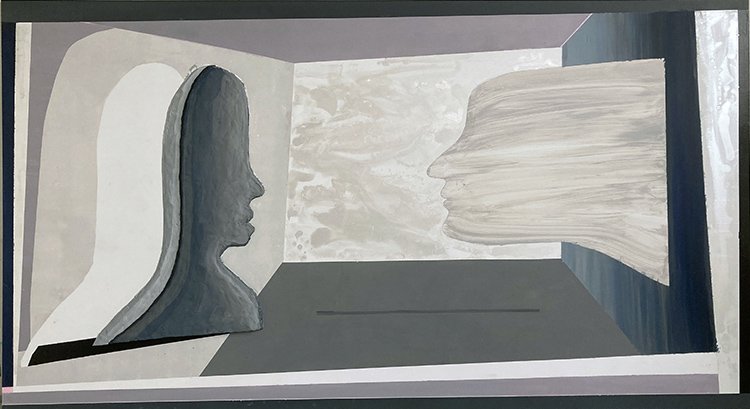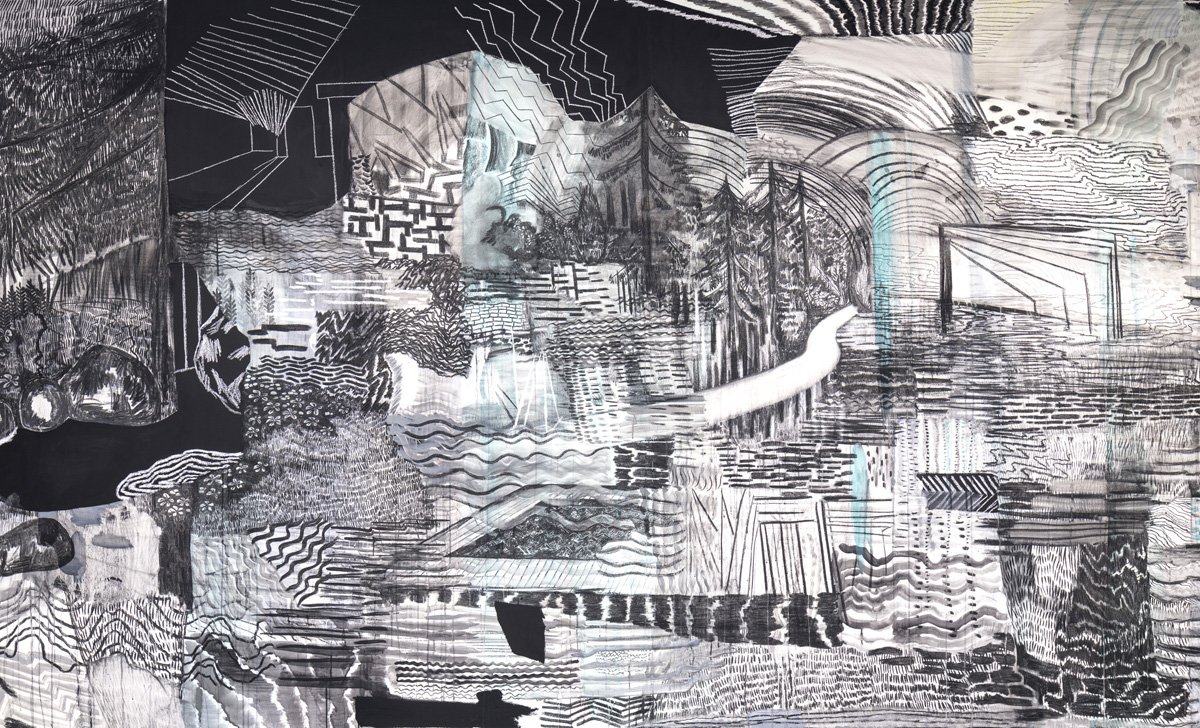
site specific
These works enter space, as a wall collage, installation, or mural. Their size create a fundamentally different experience to that of looking at a drawing; it becomes physically impossible to take in the work all at once, forcing you to wander past it, or around it. Existing architecture is used to add another layer to the play with spatiality and perspective.
‘Conversation Room’
In 2022 as part of a group show, each artist developed a site specific work for one of the alcoves in Centraal Museum’s outer wall.
Derived from a drawing on what it is like to Zoom, in this work two figures meet in an abstract room. They seem to appear from distinct realities, different as they are in texture. The play with spatiality and perspective suggests that the room consists of separate walls that can be reshaped and reassembled at any time.
‘Conversation Room’, acrylic, pearlescent ink and epoxy clay on hardboard, 106 x 190 cm, 2022. Generously supported by Stichting Stokroos. In situ photos by Adriaan van Dam.‘Connected to all’
A representation of a head, as if in a virtual space, connected to all.
De Fabriek, Eindhoven
acrylics and crayon, 340 x 350 cm., 2021
photo by Peter Cox‘Ephemeral hallway’, exhibition ‘(Real) Humans’ at Murals Inc., Rotterdam, 2021.
At a first glance you see an abstract play with shapes that are interrupted and repeated. Upon discovering an arm or leg, it becomes clear these are human figures: fragmentized silhouettes. They move through a sequence of anonymous rooms, resembling a hall of mirrors.
The existing architecture was used to make abrupt breaks spatial and thus continue the confusing game with perspective already in the work. The size emphasizes the alienating experience of a hall of mirrors.
4 x 15 metres, acrylic paint covered with pastel crayon. Photos by Indra Gleidze.‘Thin Places’
‘Thin Places’ is what the Celts referred to as places where it is easy to reach the higher forces, the unknown. This work sprouted from the question: has the digital Cloud replaced the religious God? In what way are they similar, in what way do they differ?
Wall collage of several layers of drawings, partly on transparent paper, mounted on top of each other. 210 x 780 cm, 2020. 'Future is Female' exhibition at CODA Museum in Apeldoorn, curated by Francis Boeske and Twan Janssen. photo by G.J. van Rooij.In close collaboration, Rozemarijn Westerink and Marisa Rappard developed the mural ‘Passage’ on both walls of a biking tunnel in 2020.
For the design they looked at the surrounding area. The tunnel is a most busy hub for bikers and scooters traveling from the North to the centre of Amersfoort and situated close to train station Schothorst. Surprisingly, directly next to it one finds a beautiful and quiet water-collection area. The adjacent neighbourhood is a mixture of living, working and educational buildings.
Rappard and Westerink asked inhabitants what words emerge when thinking of the tunnel and it’s surroundings. For the design they translated the words - such as nature, light, wind, commuters - and their own observations into shapes and colors.
What resulted is a collage-like mural representing the sensation of moving through the tunnel – often at high speed – experiencing a stream of impressions flowing past you, while focussing on specific things that draw attention. Rappard applied a wall-filling, colourful structure which in it’s abstraction refers to architectonical elements, as well as hurrying travellers, and nature closeby. Westerink inserted figurative elements: birds, plants, houses and sceneries to be found in the surroundings. Photos by Rik Klein Gotink.
‘vorm om; vormt om; vormde om; vormden om; omgevormd’ (loosely translating into reshape; reshapes; reshaped; reshaping) . A close collaboration with Marieke de Jong.
In 2019 at Kunstenlab in Deventer De Jong and Rappard developed a site specific installation: a drawing you can enter. On the outside of this work, radically crossing the space, organized abstract structures can be seen. Once having entered you find yourself in an area where you are forced to let go of certainties: the drawing completely desintegrates into a stream of lines and blots. Coming out on the other side of this mirrored structure, you see an altered copy of the first drawing on the front side. Smaller maquette works interacting with the large work tilt your perspective.
The artists continued their collaboration at Museum Rijswijk for the Paper Biennal 2020 and made another site-specific work. Continuing the staircase giving entrance to the room, this monumental looking work in fact is not as reliable as it seems, consisting of empty cardboard volumes. In the open volumes at both sides a labyrinthic construction of stairways can be seen, which, like the work itself, give little certainty on which path to take.
De Jong usually works three dimensionally as does Rappard on the flat surface. In this experimental project they investigated how their individual visual languages and working methods can be combined.
All photos of Kunstenlab taken by Peter Cox. Photos Museum Rijswijk by Rik Klein Gotink. Project supported by Stichting Stokroos and Mondriaan Fund.
‘Dispersed Signals’ is a commissioned mural in the conference room of an office in Amsterdam made in 2018.
After covering the wall with a black shape of chalkboard paint Rappard drew on it with acrylic paint, coloured ink, crayon and pencil.
It represents a stream of digital information, full of memes, illusions, virtual reality and distortions.
Photos by Maarten Rots.
Over the course of three months in 2018 Marisa Rappard and Rozemarijn Westerink worked on a mural, at the artist-in-residence studio of the K.F. Hein Fund in Utrecht. Exploring ways to move towards each other from their individual vantage points - drawing, erasing, redrawing, moving around lines of the other and covering them with their own - they created a dense stream of abstract lines in which structures and images appear. Like the working process itself, the drawing suggests a rhythmic movement fading and swelling, resembling the rise and retreat of the tide.
A short documentary (12 mins) has been made about the working process: http://www.artforever.nl/videos/getij/ (if you click ‘subtitles’ they will appear)
The work has been erased, yet a publication remains with a photo of the complete mural in a design by Jan Pieter Karper and with a text by Diana Wind. You can order it by sending an e-mail. Photos of the work by Peter Cox.
‘Rampant Drawings’ - wall drawing project at Extrapool, Nijmegen
white crayons on black chalkboard paint
265 x 220 cm, 2016



























